Can We Have Class Outside?
If you’re in school right now, you’ve probably heard this question a hundred times over the last week. The sun is shining, the shorts are breaking out, and everybody is antsy. Sitting through a lecture with that dead look in your eye is no longer appealing; suddenly you’re upright, staring at the window while the sun calls to you. So you ask the teacher, Can we have class outside? For whatever reason, teachers are rarely receptive to this idea. Instead, you must wait for the last agonizingly slow tick of the clock before you can rush out into the Spring air. To make up for the stuffy classroom, I find reading outside to be the perfect antidote. Here are some perfect books to read while laying out in your choice of a hammock, a chair, or a blanket.
Wild Fierce Life
Dangerous Moments on the Outer Coast
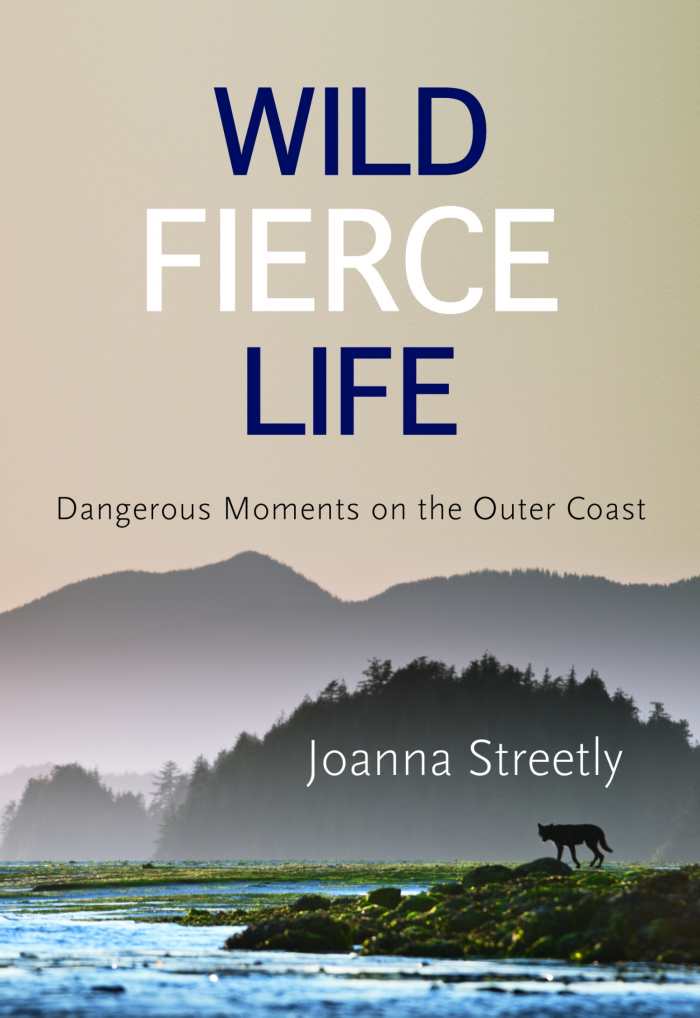
Joanna Streetly
Caitlin Press
Softcover $22.95 (224pp)
978-1-987915-65-5
Buy: Local Bookstore (Bookshop), Amazon
Joanna Streetly was just nineteen when she moved to Tofino, on the west coast of Vancouver Island. “It was a time before the technology explosion, when boats were expected to leak, or sink, and boat motors were expected to be fickle,” she writes. “It was an era uncomplicated by cellphones or GPS—or even wealth—when simply having a compass elevated me above those who approached the fog with mumbled prayers, or fingers crossed.” And it was a place that valued a good story.
Streetly’s memoir is filled with the raw intensity of life-or-death moments in the wild, and reflections on how they opened uncharted regions within her. Working as an outdoor guide, leading others on kayak or whale-watching tours, she learned the treachery of this wilderness: how islands that seemed like paradise in the summer were deadly in the winter, blasted by fierce storms.
She tells of being swept out to sea, facing likely death in the cold water, yet feeling only peace; of how lack of daylight and long periods of isolation could disrupt sleep and bring on hallucinations; of her surprise at finding herself swimming alongside a bear; and of fighting her need to prove herself equal to a man in facing challenges thrown at her by this untamed land.
She tells of her years partnered with a First Nations man, and the crumbling of both their float house and their relationship; of conflicts between white and aboriginal peoples; of a new relationship and the birth of a daughter; of learning to balance her fear for her child’s safety with the risk of destroying her delight in the wild.
She has given us good stories of breathtaking adventures, both beautifully crafted and enchanting.
KRISTINE MORRIS (April 27, 2018)
Epic Bike Rides of the World
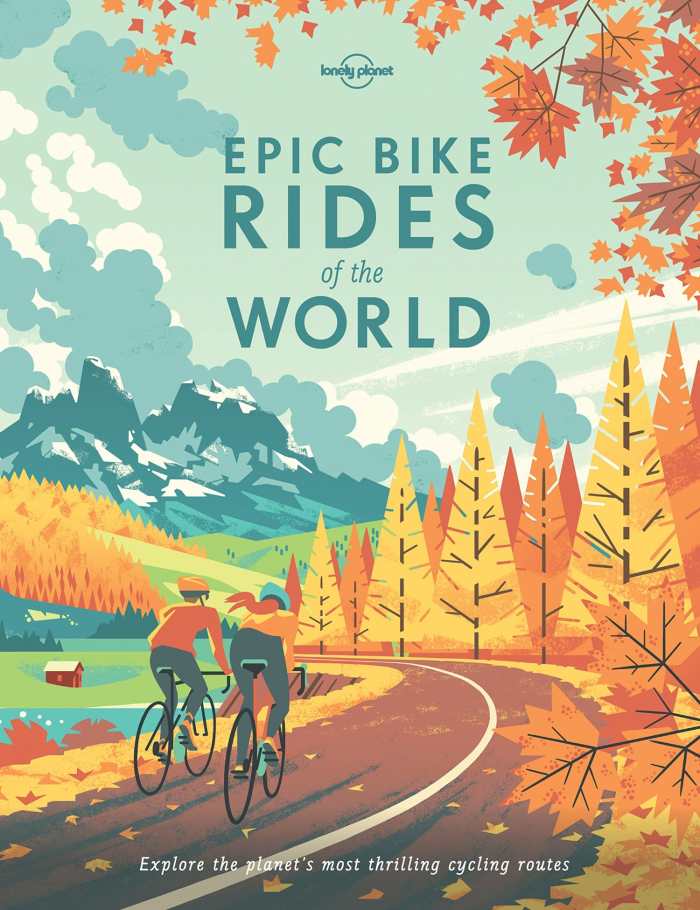
Lonely Planet
Lonely Planet
Hardcover $35.00 (320pp)
978-1-76034-083-4
Buy: Local Bookstore (Bookshop), Amazon
At first glance, what stands out most about this volume is its beauty—the gorgeous cover, the breathtaking interior photos full of personality, the maps that are simple and useful yet visually appealing. But that level of excellence and attention to detail simply befits the beautiful world these memorable bike rides showcase, and this volume contains information and insight that reach far beneath the surface.
The book focuses on fifty featured routes, each one paired with three bonus ideas of similar rides. The rides are organized by continent, with the Americas and Europe having the most rides (two in Africa). Each ride has a map showing an overview of the ride path and a map showing where the ride is in the country. Then, each has a luscious, engagingly personal firsthand description of the ride, with a straightforward description and the intangible flavor of the experience. The narrators are clearly travel enthusiasts, so they pay attention to culture and history as well as fun and adventure. The toolkit sidebars provide at-a-glance data on each ride, plus where to find out more.
The book has the expertise and excellence you’d expect from Lonely Planet. It is best suited to experienced cyclists, but it by no means requires the most advanced skills, readers are assured. The table of contents features icons that indicate the difficulty of each ride, and the narratives give a sense of physical difficulty of the terrain. There are rides for twenty-something trekkers as well as families and retirees. And even armchair cyclists will enjoy paging through the book. With everything adventurers and cycling enthusiasts need to get inspired and pull off the rides of a lifetime in every corner of the globe, riders will only be sorry that this book is a bit hefty to take along on their adventures.
MELISSA WUSKE (November 28, 2016)
A Spiritual Field Guide
Meditations for the Outdoors
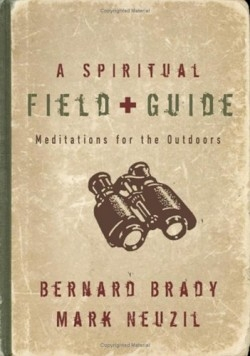
Bernard Brady, editor
Mark Neuzil, editor
Brazos Press
Unknown $12.99 (192pp)
978-1-58743-118-0
Buy: Amazon
“We rest between the gunwales of our canoe at a quiet bay on a Canadian Shield lake, watching the loons or a bear, smelling the white cedar trees and the tamarack swamp, and see evidence of a divine hand.” This kind of experience led the authors to assemble a collection of readings that highlight the link between nature and spirituality. Brady is a theology professor, and Neuzil is a professor of journalism and mass communications, both at the University of St. Thomas in St. Paul, Minnesota. Their anthology draws heavily from Christian scripture and writings, but is rounded out with pieces from a wide range of sources including the Talmud, Confucius, Lao Tzu, Chief Seattle, and other ancient and modern secular authors.
Meant as a book to be enjoyed outdoors, this guide offers selections to fit any time or place. Readers might sit by the campfire on a moonlit night and discover the thoughts of an astronaut who experienced the opposite view: that of Earth from the lunar surface. Or, sitting by a stream, one can reflect on Annie Dillard’s love for her own special spot, Tinker Creek, or on the sacredness of water in religion by remembering John’s baptisms in the river Jordan. Works from the section called “All God’s Creatures” remind one to stop for just a moment and notice the wildlife present in a backyard. All of these places and beings have a spiritual connection, and slowing down long enough to reflect on them can have a healing effect on today’s hurried and stressed souls.
Well organized into in five thematic sections, each with an introduction by the authors along with background information, this book is perhaps best read much like the Bible itself: not from cover to cover, but by selecting different pieces according to one’s mood or circumstance. The authors also suggest some optional reading plans tailored to weeklong trips, weekend trips, day trips, and “backyard breaks.” Each piece is short enough that readers could even catch a five-minute meditative break on their lunch hour.
The authors believe that nature was created by God and reflects His glory, and that He meant for humans to be responsible for it while understanding that they are interdependent with it. Their beliefs, however, do not dominate this book so much as act as a starting point for readers to determine their own stance on nature. Brady and Neuzil extend an invitation to readers to honestly think about important questions like who they are and what their role is in the world. The carefully chosen selections in this volume, whether read under the shade of a backyard maple or atop an arduously climbed mountain, can help readers ponder these points.
Your Guide to Forest Bathing
Experience the Healing Power of Nature
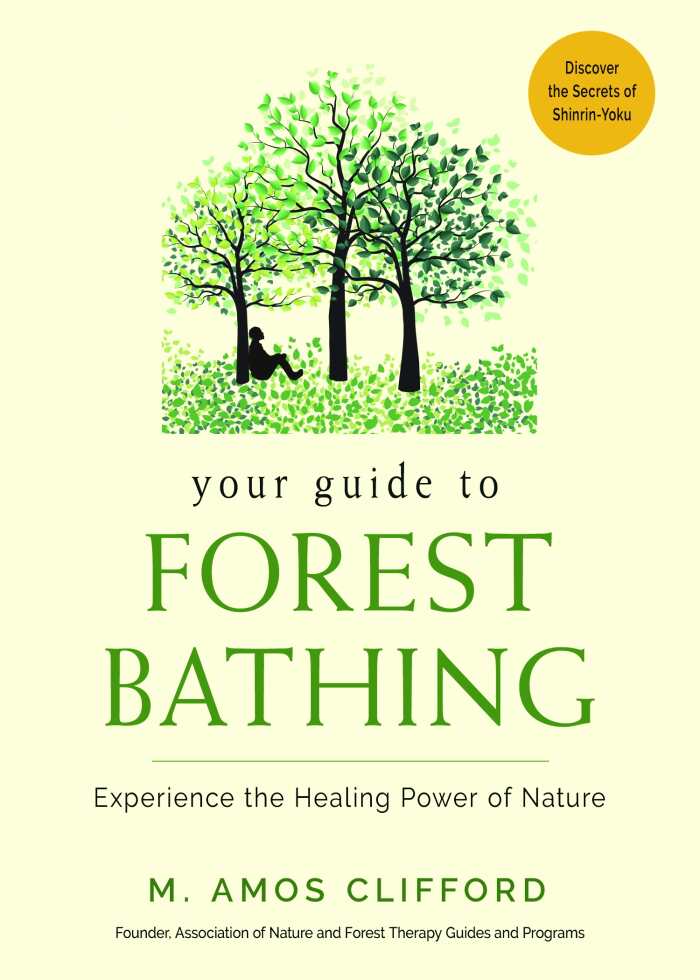
M. Amos Clifford
Conari Press
Softcover $14.95 (192pp)
978-1-57324-738-2
Buy: Amazon
Deeply encoded in the human psyche is the awareness that comfort, peace, and healing can be found in a forest. The Japanese have a term for this: shinrin-yoku, or “forest bathing.” They have long understood that being in a forest is to immerse oneself in grace and beauty and to feel the healing power that exists in the exhalations of the trees.
M. Amos Clifford is a forest guide, psychotherapist, restorative justice worker, and longtime Zen meditation practitioner. His book is a beautiful exploration of forest bathing, a source of information on the medical and scientific evidence of its benefits, and a guide to all that’s needed for a fulfilling forest-bathing practice.
Evolutionary adaptation has not kept up with the rapid pace of change, leaving us vulnerable to stress, physical and mental illness, and fractured relationships with each other and with the natural world. Trees are slow, patient beings; keepers of history, they remind us of a slower, gentler way to live. “Forest bathing resets our nervous systems,” Clifford writes. “It does so quickly and effectively. It is as if we have come home.”
The benefits are reciprocal: we exhale the carbon dioxide that the trees breathe and in turn inhale their exhalations, shown by research to be a “rich mix of freshly minted oxygen and other aerosols that benefit our moods, our hearts, our mental capacities, our immune systems, and more.”
Estranged from the natural world, we’ve come to view trees as ornamental or as crops to be harvested for a price, but Clifford affirms that, deep in our DNA, we remember the power, beauty, and generosity of trees. “We deeply intuit that it is our birthright to recall their songs,” he writes.
KRISTINE MORRIS (April 27, 2018)
Bears Ears
Views from a Sacred Land
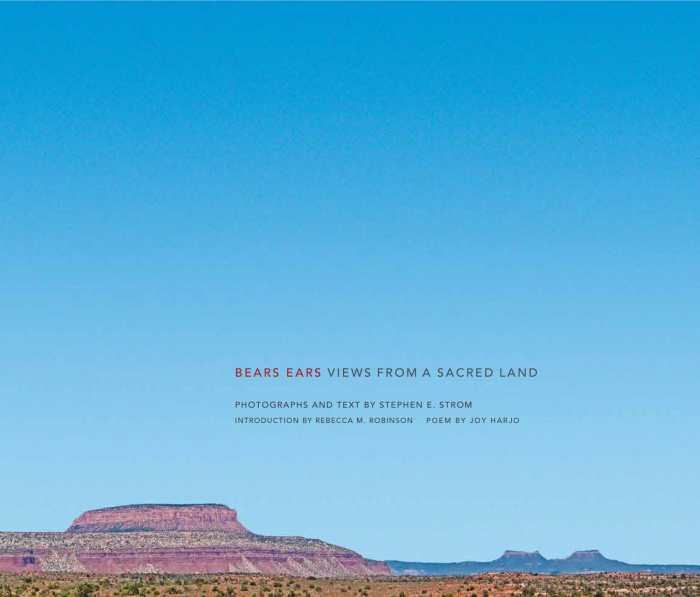
Stephen E. Strom
George F. Thompson Publishing
Hardcover $40.00 (240pp)
978-1-938086-56-4
Buy: Local Bookstore (Bookshop), Amazon
Bears Ears National Monument has been in the news of late as the Trump administration sought to dramatically scale back its protected acreage. Bears Ears: Views from a Sacred Land is a visual and literary introduction to this singular landscape, with a thorough textual tour of its social and geological history alongside Strom’s dazzling color photographs and a prayer-poem by Joy Harjo.
The monument derives its name from twin buttes that resemble two pointy ears poking out from the desert horizon. Strom’s panoramic, aerial, and other sharp photographs capture alluring and complex patterns in the rocky landscape in different seasons and lighting. From the subtle pastel striations in the sedimentary rock to dramatic sunset shadows and snow-tipped canyons and mountains, it’s a vibrant photographic portrait of a remote, almost otherworldly geography.
Capping the photographic survey is Strom’s lyrical essay about how this unique place exhibits many aspects of Earth’s formation and provides “a visible record of deep time.” The former research astronomer brilliantly decodes billions of eons in the development of the solar system and the terrestrial crust, oceans, atmosphere, and life forms, all of which are documented in various parts of Bears Ears.
Included are photographs of ancient pictographs, petroglyphs, and structures from the one hundred thousand archaeological and sacred sites studding Bears Ears. In President Obama’s 2016 national monument designation, he established the first collaborative land management system between the federal government and an intertribal coalition, whose Native American ancestors had inhabited these lands over two millennia. This precedent-setting move is controversial among Utah’s current crop of politicians and many Anglo-Mormon residents, though, and Bears Ears’ future is now in litigation. This book importantly documents what could be lost to us all in this magnificent but endangered region.
RACHEL JAGARESKI (February 27, 2018)
The Lost Art of Reading Nature’s Signs
Using Nature to Find Your Way, Predict the Weather, Locate Water, Track Animals—and Other Forgotten Skills
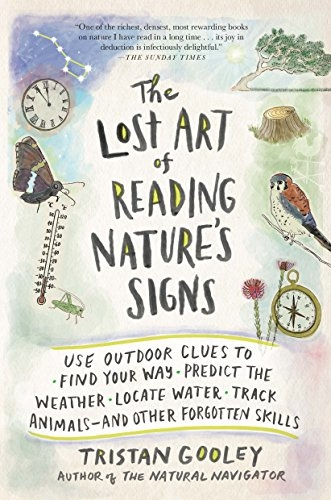
Tristan Gooley
The Experiment Publishing
Softcover $16.95 (370pp)
978-1-61519-241-0
Buy: Local Bookstore (Bookshop), Amazon
Gooley’s playful and relaxed tone imparts as steady a pace as one might expect on a stroll through the woods.
How rare to find a book that is truly brilliant. The Lost Art of Reading Nature’s Signs, by Tristan Gooley, is brilliant in the English slang sense (as in being terrific); it is brilliant in its comprehensive conveyance of all the ways to interpret natural and man-made landscapes; and brilliance glitters from Gooley’s sparkling wit.
The author leads natural-navigation workshops and has a fun, engaging way of relaying his vast knowledge about the outdoors. The book is intended for walkers “who like to feel their minds flex with their legs,” and is stuffed with information about ways to “read” stars, sounds, plants, animals, and the elements. There are serious discussions about orienteering at night using astronomical principles, both ancient and modern, but an equal emphasis on knowledge gleaned from farmers, folklore, and Gooley’s years of observation, including such nuggets as noticing that increased presence of dog turds means that human habitation is ahead.
This compendium of outdoor skills and knowledge is greatly enhanced by the careful line drawings. These illustrations punctuate the text at frequent intervals and promote deeper understanding of Gooley’s concepts. It is one thing to read his paragraph-long description of how to find the North Star in the Big Dipper constellation, but the illustration gets the point across instantly. Several chapters narrating walks in his usual English haunts, Edinburgh, and with Dayak tribesmen in remote areas of Borneo show how Gooley knits all of this information together, and they are a nice contrast to the weightier subject chapters. The book concludes with a checklist that collects the preceding information into an “invisible toolbag” for outdoor adventures.
While the inveterate hiker and wilderness camper might get the most mileage out of this volume, it is useful to anyone who travels frequently, wants to be more nature literate, or seeks a deeper enjoyment of their outdoor walks. Or maybe you fancy flipping through all these informational tidbits “for no other reason than it’s sometimes fun to know things that almost no other walker knows.”
RACHEL JAGARESKI (August 27, 2015)
Hannah Hohman
